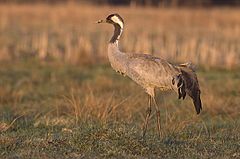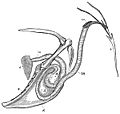Common crane facts for kids
Quick facts for kids Common crane |
|
|---|---|
 |
|
| Conservation status | |
| Scientific classification | |
| Kingdom: | |
| Class: | |
| Order: | |
| Family: | |
| Genus: | |
| Binomial name | |
| Grus grus (Linnaeus, 1758)
|
|
The common crane (Grus grus), also known as the Eurasian crane, is a bird of the family Gruidae, the cranes. It is the only crane commonly found in Europe apart from the demoiselle crane.
Contents
Habitat
In Europe, the common crane breeds in boreal and taiga forest and mixed forests, from sea-level to 2,200 m (7,200 ft). It also lives on treeless moors, on bogs, or on dwarf heather habitats, usually where small lakes or pools are also found.
In Sweden, breeders are usually found in small, swampy openings amongst pine forests while, in Germany, marshy wetlands are used. Breeding habitats in Russia are similar, though they can even be found nesting in the steppe and in semi-desert, so long as water is near. Mostly, common cranes are found breeding in wooded swamps, bogs and wetlands. They seem to need quiet, peaceful enivrons with little human interference. They live in low density, from 1 to 5 pairs per 100 km2 (39 sq mi).
During winter, the birds move to flooded areas, shallow sheltered bays, and swampy meadows. During the flightless moulting period there is a need for shallow waters or high reed cover for concealment. Later, after the migration period, the birds winter regularly in open country, often on cultivated lands and sometimes also in savanna-like areas, for example on the Iberian Peninsula.
Back to Britain
Cranes are back in Britain after 300 years. They were devastated by the draining of the fens 300 years ago. This was a low-lying wetland which was one of their favourite habitats.
Images for kids
-
Common cranes in Osmussaar, Estonia. Wetlands are preferred habitats for the cranes.
-
Adults and immatures at Keoladeo National Park, India
-
A smal flock of Cranes in flight, Ystad 2022.
See also
 In Spanish: Grus grus para niños
In Spanish: Grus grus para niños






















